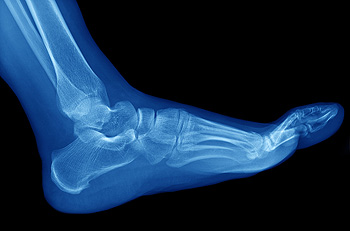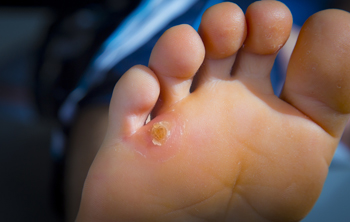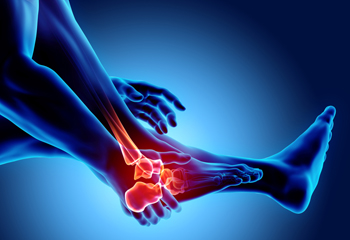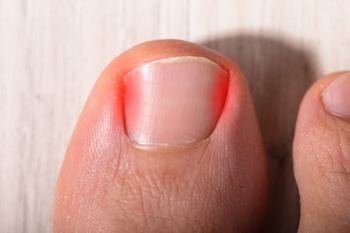Items filtered by date: August 2021
What Are the Treatments for Foot Corns?
Corns are small lumps of thickened, hardened skin that occur due to friction or pressure on an area of the foot. They are most often located in between the toes, on top of the toes, or on the soles of the feet. Corns can be uncomfortable or even painful, but non-surgical treatment is usually successful. Most of these treatments work by off-loading, or taking the pressure off of, the corn. Your doctor may ask you to wear a padded corn sleeve over the corn if it is located on your toe. If the corn is located between the toes, you may be asked to wear a toe spacer between the affected toes to take pressure and friction off the corn. A corn donut, which is a padded, donut-shaped device, can be placed around the corn to off-load it. If it is associated with a large callus, your doctor can also trim the corn. If you suffer from painful foot corns, please schedule an appointment with a podiatrist near you.
Corns can make walking very painful and should be treated immediately. If you have questions regarding your feet and ankles, contact Dr. John P. Beaupied of Palos Podiatry. Our doctor will treat your foot and ankle needs.
Corns: What Are They? And How Do You Get Rid of Them?
Corns are thickened areas on the skin that can become painful. They are caused by excessive pressure and friction on the skin. Corns press into the deeper layers of the skin and are usually round in shape.
Ways to Prevent Corns
There are many ways to get rid of painful corns such as:
- Wearing properly fitting shoes that have been measured by a professional
- Wearing shoes that are not sharply pointed or have high heels
- Wearing only shoes that offer support
Treating Corns
Although most corns slowly disappear when the friction or pressure stops, this isn’t always the case. Consult with your podiatrist to determine the best treatment option for your case of corns.
If you have any questions please feel free to contact our office located in Palos Heights, IL . We offer the newest diagnostic and treatment technologies for all your foot and ankle needs.
Simple Exercise for Rheumatoid Arthritis Foot Pain
If you have rheumatoid arthritis, you may be experiencing joint pain and stiffness in your feet. Gentle exercises can help reduce foot pain for people dealing with this condition. One simple exercise that you can try is rolling a stress ball with your foot so that the ball is underneath the front part of your heel. This helps stretch the plantar fascia, a ligament that runs along the bottom of your foot and supports your arches. You can do this exercise while sitting or standing. To learn more about how to take care of your feet with a diagnosis of rheumatoid arthritis, and to learn more about helpful exercises you can practice, please consult with a podiatrist.
Because RA affects more than just your joints, including the joints in your feet and ankles, it is important to seek early diagnosis from your podiatrist if you feel like the pain in your feet might be caused by RA. For more information, contact Dr. John P. Beaupied of Palos Podiatry. Our doctor will assist you with all of your podiatric concerns.
What Is Rheumatoid Arthritis?
Rheumatoid Arthritis (RA) is an autoimmune disorder in which the body’s own immune system attacks the membranes surrounding the joints. Inflammation of the lining and eventually the destruction of the joint’s cartilage and bone occur, causing severe pain and immobility.
Rheumatoid Arthritis of the Feet
Although RA usually attacks multiple bones and joints throughout the entire body, almost 90 percent of cases result in pain in the foot or ankle area.
Symptoms
- Swelling and pain in the feet
- Stiffness in the feet
- Pain on the ball or sole of feet
- Joint shift and deformation
Diagnosis
Quick diagnosis of RA in the feet is important so that the podiatrist can treat the area effectively. Your doctor will ask you about your medical history, occupation, and lifestyle to determine the origin of the condition. Rheumatoid Factor tests help to determine if someone is affected by the disease.
If you have any questions please feel free to contact our office located in Palos Heights, IL . We offer the newest diagnostic and treatment technologies for all your foot and ankle needs.
How Do Stress Fractures Affect the Feet?
 A stress fracture is a small hairline fracture that is a result from overuse. The feet are particularly susceptible to developing stress fractures and there are a variety of different types. One of the most common foot stress fractures is a navicular stress fracture. This occurs on the top of the midfoot and is common in sprinters and jumpers. Another type of stress fracture is a metatarsal stress fracture which occurs along one of the metatarsal bones. A metatarsal stress fracture can develop from overuse or poor foot biomechanics and the pain is usually felt towards the middle, or front of the foot and worsens with weight bearing activities. A calcaneal fracture occurs in the heel bone and is common among soldiers who march frequently, as well as runners who choose to do their running on the road. Another common stress fracture that may occur in the feet is a Jones fracture which occurs in the 5th metatarsal and causes pain on the outside of the foot. If you are experiencing pain in the foot, it may be the result of one of these stress fractures. Consult with a podiatrist for a proper diagnosis and plan for treatment.
A stress fracture is a small hairline fracture that is a result from overuse. The feet are particularly susceptible to developing stress fractures and there are a variety of different types. One of the most common foot stress fractures is a navicular stress fracture. This occurs on the top of the midfoot and is common in sprinters and jumpers. Another type of stress fracture is a metatarsal stress fracture which occurs along one of the metatarsal bones. A metatarsal stress fracture can develop from overuse or poor foot biomechanics and the pain is usually felt towards the middle, or front of the foot and worsens with weight bearing activities. A calcaneal fracture occurs in the heel bone and is common among soldiers who march frequently, as well as runners who choose to do their running on the road. Another common stress fracture that may occur in the feet is a Jones fracture which occurs in the 5th metatarsal and causes pain on the outside of the foot. If you are experiencing pain in the foot, it may be the result of one of these stress fractures. Consult with a podiatrist for a proper diagnosis and plan for treatment.
Activities where too much pressure is put on the feet can cause stress fractures. To learn more, contact Dr. John P. Beaupied from Palos Podiatry. Our doctor can provide the care you need to keep your pain free and on your feet.
Dealing with Stress Fractures of the Foot and Ankle
Stress fractures occur in the foot and ankle when muscles in these areas weaken from too much or too little use. The feet and ankles then lose support when walking or running from the impact of the ground. Since there is no protection, the bones receive the full impact of each step. Stress on the feet can cause cracks to form in the bones, thus creating stress fractures.
What Are Stress Fractures?
Stress fractures occur frequently in individuals whose daily activities cause great impact on the feet and ankles. Stress factors are most common among:
- Runners
- People affected with Osteoporosis
- Tennis or basketball players
- Gymnasts
- High impact workouts
Symptoms
Pain from the fractures occur in the area of the fractures and can be constant or intermittent. It will often cause sharp or dull pain with swelling and tenderness. Engaging in any kind of activity which involves high impact will aggravate pain.
If you have any questions please feel free to contact our office located in Palos Heights, IL . We offer the newest diagnostic and treatment technologies for all your foot and ankle needs.
Plantar Warts Can Be Treated!
Signs of a Broken Foot
 There are 26 bones in the foot and recognizing the symptoms of a broken bone is important for ensuring the overall health of your feet. A broken foot can be as simple as a small hairline fracture (such as a stress fracture), or it can be a severe break that tears or pierces the skin. The most common symptoms of a broken foot are pain, swelling, and bruising. Other common signs include a snapping or grinding sensation at the time of injury, difficulty or pain when moving the affected foot, inability to bear weight on the foot, tenderness from touching the injury, and difficulty walking. Telling the difference between a broken foot and a sprained foot can be difficult. That is why anyone who believes that they may have a broken foot should consult with a podiatrist for a proper diagnosis. A podiatrist will also be able to help provide the best treatment options for the broken bone.
There are 26 bones in the foot and recognizing the symptoms of a broken bone is important for ensuring the overall health of your feet. A broken foot can be as simple as a small hairline fracture (such as a stress fracture), or it can be a severe break that tears or pierces the skin. The most common symptoms of a broken foot are pain, swelling, and bruising. Other common signs include a snapping or grinding sensation at the time of injury, difficulty or pain when moving the affected foot, inability to bear weight on the foot, tenderness from touching the injury, and difficulty walking. Telling the difference between a broken foot and a sprained foot can be difficult. That is why anyone who believes that they may have a broken foot should consult with a podiatrist for a proper diagnosis. A podiatrist will also be able to help provide the best treatment options for the broken bone.
A broken foot requires immediate medical attention and treatment. If you need your feet checked, contact Dr. John P. Beaupied from Palos Podiatry. Our doctor can provide the care you need to keep you pain-free and on your feet.
Broken Foot Causes, Symptoms, and Treatment
A broken foot is caused by one of the bones in the foot typically breaking when bended, crushed, or stretched beyond its natural capabilities. Usually the location of the fracture indicates how the break occurred, whether it was through an object, fall, or any other type of injury.
Common Symptoms of Broken Feet:
- Bruising
- Pain
- Redness
- Swelling
- Blue in color
- Numbness
- Cold
- Misshapen
- Cuts
- Deformities
Those that suspect they have a broken foot shoot seek urgent medical attention where a medical professional could diagnose the severity.
Treatment for broken bones varies depending on the cause, severity and location. Some will require the use of splints, casts or crutches while others could even involve surgery to repair the broken bones. Personal care includes the use of ice and keeping the foot stabilized and elevated.
If you have any questions please feel free to contact our office located in Palos Heights, IL . We offer the newest diagnostic and treatment technologies for all your foot and ankle needs.
Ingrown Toenail Treatments
Ingrown toenails are an annoying but typically mild problem that occurs when the corner or edge of a toenail grows into the surrounding skin, rather than over it. This can cause the skin to become red, swollen, tender, or painful. Ingrown toenails can often be managed with home treatment and footwear modifications. Over the counter anti-inflammatory medications can reduce pain and swelling. Sometimes an ingrown toenail can result in an infection. Your podiatrist can prescribe antibiotics if this occurs. When it comes to the ingrown toenail itself, your podiatrist may remove the ingrown part of the nail through a procedure called partial nail avulsion. To prevent ingrown toenails, it is suggested that you trim your toenails straight across and not too short using nail clippers, and that you wear shoes that are not too tight in the toes. For more information about ingrown toenails, please consult with a podiatrist.
Ingrown toenails can become painful if they are not treated properly. For more information about ingrown toenails, contact Dr. John P. Beaupied of Palos Podiatry. Our doctor can provide the care you need to keep you pain-free and on your feet.
Ingrown Toenails
Ingrown toenails occur when a toenail grows sideways into the bed of the nail, causing pain, swelling, and possibly infection.
Causes
- Bacterial infections
- Improper nail cutting such as cutting it too short or not straight across
- Trauma to the toe, such as stubbing, which causes the nail to grow back irregularly
- Ill-fitting shoes that bunch the toes too close together
- Genetic predisposition
Prevention
Because ingrown toenails are not something found outside of shoe-wearing cultures, going barefoot as often as possible will decrease the likeliness of developing ingrown toenails. Wearing proper fitting shoes and using proper cutting techniques will also help decrease your risk of developing ingrown toenails.
Treatment
Ingrown toenails are a very treatable foot condition. In minor cases, soaking the affected area in salt or antibacterial soaps will not only help with the ingrown nail itself, but also help prevent any infections from occurring. In more severe cases, surgery is an option. In either case, speaking to your podiatrist about this condition will help you get a better understanding of specific treatment options that are right for you.
If you have any questions please feel free to contact our office located in Palos Heights, IL . We offer the newest diagnostic and treatment technologies for all your foot and ankle needs.







